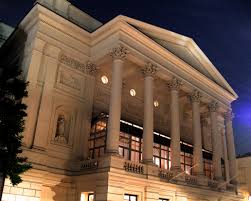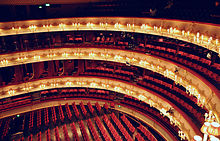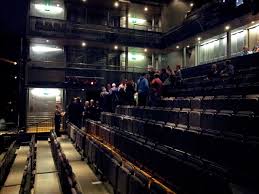Royal Opera House
From Londonhua WIKI
Revision as of 12:52, 9 June 2017 by Mthatfalvi (talk | contribs)
Royal Opera House
Overview
After the British Civil War, only two theaters were instated for 28 years. Those theaters were the Drury Theater and the Royal Opera House. The Opera House burned down twice before the current building was built. Two years ago the Royal Opera House doubled its size and renovated the existing parts of the building. The total cost was over £200 million. The Royal Opera House now has two proscenium theaters and eight dance studios. There are also two sister dance schools that are considered amongst the most prestigious in the world next to France and Moscow.
Contents
History
The Royal Opera House did not start as the Royal Opera House. It was formally called Covent Garden and Theatre Royal. In the beginning in 1732, the theatre was a playhouse. The the fire in 1808 destroyed the theatre. The second Theatre Royal or Covent Garden was designed by Robert Smirke and opened in 1809. Sadly this was also destroyed in a fire in 1856. The theatre which stands today was built in 1858. This building was designed by Edward Middleton Barry,
According to the Royal Opera House history page, during World War II The Royal Opera House was used as a dance hall. Now the Royal Opera House is the home of both the Royal Opera, which was founded in 1946 as the Covent Garden Opera Company, and The Royal Ballet which was founded in 1931 then moved to the house in 1946. [1]
Theater Space
Main Stage
The original auditorium is used as the main theater. It has over 2,500 seats. The main stage is proscenium style with no apron. The stage is 15 meters square. The orchestra pit can fit 90-109 musicians. The floor of the pit is hydraulic and has three heights. The top level is used for concerts. The second level is used for smaller orchestra shows. The third and lowest level of the pit is used for large orchestra shows. This enables more musicians to fit in the pit and for dampening of the sound so the performers can be better heard. While it was recently redone, the auditorium retains its original renaissance style. It even still has a box for the royal family that was first created for Queen Elizabeth I. There is also an adjoining room for the royal family to eat and wait in before the show.
Linbury Studio
The Linbury Studio is the secondary theater used for smaller and experimental shows. It seats 400 guests. This stage is also in the proscenium style.
Scenic
The Royal Opera House makes all of its own sets off-site in Thurrock. There the sets are fabricated, deconstructed and sent to the theater. Upon arrival at the theater, the tractor trailer holding the pallets filled with the set backs into a massive elevator. This elevator then brings the truck to the unloading bay where the pallets are stored on a conveyor system. This system is then integrated with the wagon system that Rolls Royce designed for the theater. The wagon system allows for extremely fast set changes between shows, only 20 minutes. The stage floor rests on three wagons with the rest of the set on top. The stage has a hydraulic floor system. To switch between shows, the current floor can be raised and transported out of the way allowing the new floor to slide and be lowered into place. That process takes only 40 seconds. The Royal Opera House is one of only two theaters to have this system.
Props
The Royal Opera House would not be complete to make a show without it's Prop department. This includes of team of artists, sculptors, engineers and welders. Mostly all of the props are made in this department or acquired from warehouse storage. Beautiful props complete the performances and a lot of work goes into each production. Anything can be made and anything can be changed to look like something it isn't. For example, plaster, molds, and paint can be made to look like food. [2]
Lighting & Projections
Unlike many theaters, the Royal Opera House has their lighting fixtures located in a panel that can lower from the dome of the roof. When the lights are not needed for a show, the panels retract and blend in with the rest of the dome. This concept was to keep the proscenium free from truss and fixtures that would distract the viewer from the performance or obstruct their view. When the renovation was being done on the theater, the ETC lighting company received the contract to provide and setup numerous fixtures, consoles and a house control system. They also have lights on the back stage batons so that the dancers and singers can see on stage.
Sound
When the theater was rebuilt two years ago, the sound designers decided to remove the carpeting from the stairs and floors. This was to give the theater better acoustics because the singers or instrumentalists do not use microphones. There is not much need for a sound system for the operas and ballets because the performers do not have microphones and the music is provided by the orchestra.
Costumes
The Royal Opera House makes all of their costumes in house. There are three sub-departments in their costume department. The first is in charge of creating costumes for the first performance of a show. The other two departments are in charge of care, maintenance and organization of the costumes. After the first show, costumes become their responsibility. They take care of laundry and mending any damage to the costumes. After a show has completed its run, costumes are then put into storage off-site until the next run of the show. Properly stored and cared for costumes can last for decades of use.
Performances
Pygmalion (1734)
Performance Summary
This performance was shown on the 14th February 1734 with Marie Sallé as Galatea and choreographer. [3] The music was by Jean-Joseph Mouret. The ballet plot was about Pygmalion, king of Cyprus, who carved a statue of his ideal woman and fell in love with her. [4] Aphrodite then brought the sculpture to life and Pygmalion married her. The name Galatea was the name given to the statue for this interpretation and other performances [4] This performance was put on when the Royal Opera House was called Convert Gardens before the second fire. According to an article on Marie, she danced in a muslin costume with her hair down and un-ornamented which emphasized her belief that dance should be natural. [5]
Reviews
At the time, ballet dancers would dress in extravagant costumes with corsets. This did not give freedom for much movement. It was unheard of what Marie Sallé did in this performance. According to a review from her endeavor "For nearly two months Pygmalion has been given without any sign of failing interest...You can imagine, Sir, what the different stages of such an action can become when mimed and danced with the refined and delicate grace of Mlle. Sallé. She has dared to appear in this entree without pannier, skirt or bodice and with her hair down; she did not wear a single ornament on her head. Apart from her corset and petticoat she wore only a simple dress of muslin draped about her in the manner of a Greek statue." [5]
Marie was complemented in many reviews for her success & genius in her decision & performance. She even got to perform for the royal family and court of the day. One review about her performance said that, "Sallé had talents to open a thousand purses" [6] Apparently she could bring a lot of people to a theater and the theater made money. Overall, this performance was a breakthrough in ballet history with costumes and style.
The Dream / Symphonic Variations / Marguerite and Armand (2017)
Performance Summary
The performance was a combination of three one act ballets all choreographed by Frederick Ashton. This was the closing performance for the 70th season of the Royal Ballet at Covent Garden. The music was by Felix Mendelssohn and arranged by John Lanchbery.
The Dream is a ballet based on Shakespeare's A Midsummer Night's Dream. The plot is about the King of the Fairies Oberon who fights with his Queen Titania about their son. Oberon then orders Puck to sprinkle her eyes with a flower's potion to make her fall in love with the first thing she sees. Titania then falls for Bottom who is turned into a donkey. While this is happening, two pairs of lovers enter the story and Puck decides to mess with them. This creates havoc and finally he & Oberon make everything right with everyone. Oberon makes peace with Titania and everyone goes back to the way they were supposed to be. Oberon was played by Steven Mcrae and Titiana was Akane Takada. The chorus during the performance was sung by the London Oratory Junior Choir. The scenery had the look of an enchanted forest.
Symphonic Variations was one of the first works done by the Royal Ballet at the Royal Opera House in 1946. It is considered as one of Ashton's finest works. The act only had six dancers, 3 male and 3 female. All were dressed in white with a yellow backdrop stage. The dance according to the ballet performers was really difficult to learn. It was quick and slow and the positions used were hard and required great talent.
The most emotional performance of the night was the final act where the Prima dancer Zenaida Yanowsky was performing her last prima dance before retiring. She performed in the story of Marguerite and Armand, played by Roberto Bolle, which is about two lovers who are destined to never be together. Marguerite is a Parisian courtesan who has a passionate love affair with Armand. Within the performance there were great changes of the scenery within the one act. The scene and mood would change as quickly as Marguerite's costumes. The most memorable dance was final one before Marguerite dies.
Reviews
The reviews for this performance were very positive. Bad reviews could not be found. For Margarite and Armand, the Independent said: "Saying farewell to the Royal Ballet after 23 years, Yanowsky shows her quality as an actress, a dancer and a star. There’s a grand sweep to her movement, while her alert stage presence makes tiny moments count. When she’s forced to give up her lover, Roberto Bolle’s Armand, she holds still for a vulnerable second, trying to resist the inevitable. In her death scene, she’s ardent and feverish, clinging on to life. Bolle less at home in the grand gestures, but makes a sure, devoted partner. It’s a very moving goodbye." [7]
For The Dream a beautiful summary of the performance is given:
"The Dream opens in a 50 minute one-act ballet created to celebrate the 400th anniversary of Shakespeare’s birth. Here, Ashton has transformed the play into a sumptuous rendition of the human and fairy worlds colliding-framed by Mendelssohn’s floating incidental music.
As chords are struck in a callout to fairies, played with pitch perfect precision under Emmanuel Plasson’s watchful baton, Oberon arrives onstage and surveys the landscape as we, the audience, anticipate the arrival of magic as much through the musical timbre as the movement.
Famous for his understanding of movement and music, Ashton understood that once the dancer comprehended the musical score, they would ‘know the steps,’ and this is clearly evident in Steven McRae’s Oberon, a precise and richly virtuoso act as he spins and winds across the stage in perfect time.
Bang on tempo, McRae’s sharply executed jumps are also feat to behold as he elevates to dizzy heights, yet achieves soft landings, as if operated by invisible strings from above and noiselessly released back down onstage.
While Akane Takada’s debut as Titania lends new meaning to the phrase ‘all that’s solid melts into air.’ Here in her debut performance, Takada literally embodies her steps with such limpid and fluid grace, it’s as if she will transform into something other than human before our very eyes." [8]
According to the Stage review, Symphonic Variations "...delivers us into a coolly abstract realm that’s somehow suffused with mystery and intimations of tenderness. The curving black lines that adorn Sophie Federovitch’s yellow-green backdrop are given physical echo in the dancers’ restrained, weightless spools of movement, the women’s arms occasionally half-framing the men’s faces. Some secret, sublime knowledge seems to inhere within Marianela Nunez, shaping the profound sensitivity of her phrasing."[9]
References
- ↑ History. (n.d.). Retrieved May 20, 2017, from http://www.roh.org.uk/about/the-royal-opera/history
- ↑ Props to you! Prop-making tricks of the trade revealed - Royal Opera House. (n.d.). Retrieved May 20, 2017, from http://www.roh.org.uk/news/props-to-you-prop-making-tricks-of-the-trade-revealed
- ↑ Pygmalion (1734), accessed at http://www.apgrd.ox.ac.uk/productions/production/13155 <5 June 2017>
- ↑ 4.0 4.1 Reid, J. D., & Rohmann, C. (1993). The Oxford guide to classical mythology in the arts 1300-1900s (Vol. 2). New York: Oxford University Press.
- ↑ 5.0 5.1 Andros, D. (1991, May). Marie Salle, (1707-1756). Retrieved June 05, 2017, from http://michaelminn.net/andros/biographies/salle_marie/
- ↑ Chazin-Bennahum, J. (2005). Reformers and Philosophes as Forerunners of the Revolution in Fashion. In The lure of perfection: fashion and ballet 1780-1830 (pp. 35-64). London: Routledge.
- ↑ Anderson, Z. (2017, June 05). Frederick Ashton/Royal Ballet, Royal Opera House, London, review: Zenaida Yanowsky shows her quality as an actress, a dancer and a star. Retrieved June 09, 2017, from http://www.independent.co.uk/arts-entertainment/theatre-dance/reviews/frederick-ashtonroyal-ballet-royal-opera-house-london-review-a7773401.html
- ↑ Nouchi, R. (2017, June 6). Review: Royal Ballet - The Dream | Symphonic Variations | Marguerite and Armand. Retrieved June 09, 2017, from http://londondance.com/articles/reviews/royal-ballet-the-dream-symphonic-variations-margue/
- ↑ Winter, A. (2017, June 04). ★★★★ The Dream / Symphonic Variations / Marguerite and Armand review at the Royal Opera House, London. Retrieved June 09, 2017, from https://www.thestage.co.uk/reviews/2017/ashton-triple-bill-review-at-the-royal-opera-house-london/


